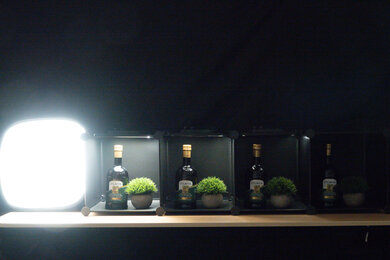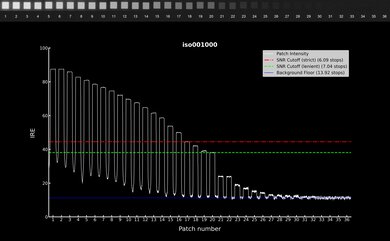The Sony RX10 IV is a premium bridge camera with a built-in superzoom lens. It has a full-frame equivalent focal length range of 24 to 600mm, giving you a lot of flexibility to zoom in on very far-away subjects or take wider-angle landscape shots. It feels very well-built and incredibly comfortable to use despite its bulky size, and its screen can tilt out to help you shoot from lower angles. Its autofocus system delivers exceptional tracking performance in video and reliably keeps moving subjects in focus, even when they're popping in and out of frame. It also has a very fast continuous shooting speed to easily capture brief moments of fast action. Overall image quality is amazing when shooting in JPEG, with excellent dynamic range and relatively minimal noise at higher ISO levels. However, its RAW noise handling capability is mediocre due to its smaller sensor, so it's not as well-suited to shooting in dimly-lit conditions.
Our Verdict
The Sony RX10 IV is decent for travel photography. It's not the easiest to travel with due to its bulky size and weight, but it does feel incredibly comfortable to use. It also has good battery performance, though this can vary with settings and usage habits. Its built-in lens also has an incredibly long focal length, so you can easily zoom in on far-away subjects. Image quality is excellent, though it's not as well suited to low light due to its smaller sensor and its lens's relatively narrow max aperture.
- Good battery performance.
- Good overall image quality for its sensor size.
- Superzoom lens.
- Bulky size.
- Limited max aperture for low light.
- Low light capability is lacking.
The Sony RX10 IV is adequate for landscape photography. It delivers great image quality overall, especially considering its smaller sensor. However, the dynamic range is somewhat limited. Thankfully, it feels well-built and incredibly comfortable to use, with a bright screen that can easily overcome glare. It's also advertised to be moisture- and dust-resistant. However, it's very bulky and heavy, so it's not the most convenient to take to remote shooting locations.
- Good overall image quality for its sensor size.
- Well-constructed.
- Bulky size.
- Dynamic range is limited.
The Sony RX10 IV is good for sport and wildlife photography. The camera feels incredibly comfortable to use, although it's bulky. Its built-in lens also has a remarkably long focal length range, so you can zoom in on very far-away subjects or take extreme close-ups. Its continuous shooting speed is very fast, as it can shoot at an outstanding 21 fps when using its electronic shutter and a still excellent 11 fps when using its mechanical shutter. The autofocus is also effective, though its tracking feature can sometimes struggle to keep up with faster subjects. While its buffer empty time is quite long, it has a big capacity, so you'll unlikely fill it in regular use.
- Good overall image quality for its sensor size.
- Very fast high-speed continuous shooting speed.
- Superzoom lens.
- Bulky size.
- AF tracking can struggle with faster subjects.
The Sony RX10 IV isn't well-suited for vlogging. You can't flip its screen around to face you, and it's very large and may be cumbersome to hold for vlogging, though it may be suitable for sit-down vloggers. It does a fantastic job tracking moving faces in 4k and FHD video, so you should remain in focus. However, its video quality is disappointing in FHD. It also does a poor job smoothing out camera shake in 4k, though it does a good job in FHD.
- Good 4k video quality.
- Incredibly effective autofocus tracking in video.
- Bulky size.
- Poor FHD video quality.
- Poor video stabilization in 4k.
- Can't flip screen around to face you.
The Sony RX10 IV is decent for studio video. It delivers good video quality when shooting in 4k resolution in brighter lighting conditions, and its low-light video quality is surprisingly good. However, there's noticeable rolling shutter effect when panning from side to side. It supports S-log picture profiles for more in-depth color grading in editing and has a range of inputs and outputs, including a microphone jack, headphone jack, and HDMI port with clean HDMI output if you want to connect an external recorder without overlays. Its autofocus system is fantastic at tracking moving subjects in video. Unfortunately, its menu system can be confusing and hard to navigate. Its FHD video quality is also disappointing.
- Good 4k video quality.
- Incredibly effective autofocus tracking in video.
- Supports Log recording.
- Bulky size.
- Poor FHD video quality.
The Sony RX10 IV isn't suitable for action video. It's very bulky and isn't designed for mounting on action cam rigs. While it's advertised as sealed against dust and moisture, it isn't waterproof. The 4k video quality is good, but the FHD video quality is disappointing. It can't shoot at high-speed frame rate in 4k, but it has a 'High Frame Rate' mode in FHD that can capture remarkably high-speed frame rates for slow-motion playback.
- High frame rate mode in FHD.
- Good 4k video quality.
- Incredibly effective autofocus tracking in video.
- Bulky size.
- Poor FHD video quality.
- Poor video stabilization in 4k.
- Not waterproof.
The Sony RX10 IV has okay RAW image quality. Its noise handling is mediocre, so images can look quite noisy in low light. Photos also lack sharpness. It has a reasonable amount of dynamic range for its class, but you'll still lose detail in high-contrast scenes. That said, for a bridge camera, its overall image quality is still good, especially when shooting in bright lighting conditions.
- Good overall image quality for its sensor size.
- Dynamic range is limited.
- Low light capability is lacking.
Performance Usages
Changelog
- Updated Feb 24, 2025: We've converted this review to Test Bench 0.13. We've added new tests for Video Dynamic Range and Luminosity Patch Detection. You can learn more about these updates in the changelog.
- Updated Jan 29, 2024: Added text to the 'Raw Photo Performance' verdict box.
- Updated Jan 29, 2024: Converted to Test Bench 0.12.1.
- Updated Sep 07, 2023: We've updated the 'Sensor Type' from 'Stacked CMOS' to 'Stacked BSI CMOS'.
Check Price
Differences Between Sizes And Variants
The Sony CyberShot RX10 IV comes in one color variant: 'Black'.
Let us know if you come across a different variant or your Sony RX10 IV doesn't correspond to our review, and we'll update it.
You can see our unit's label here.
Compared To Other Cameras
The Sony RX10 IV is better overall than the Nikon COOLPIX P1000, but it doesn't have nearly as long a zoom range. If you don't need to shoot at extremely long focal lengths, however, the Sony offers a larger sensor that captures better image quality, a weather-sealed build, and significantly better autofocus and continuous shooting modes.
The Sony RX10 IV is a better overall bridge camera than the Canon PowerShot SX70 HS. It has a larger, more powerful stacked sensor that delivers better image quality and allows for faster burst shooting. It's also better built, with more physical controls and weather-sealing, and it has a longer battery life and better autofocusing. That said, it's also a less portable camera and has a significantly shorter zoom range than the Canon.
The Sony RX10 IV is better overall than the Nikon COOLPIX P950. While the built-in lens on the Nikon has a much longer zoom range for those who need it, the Sony has a larger sensor and, therefore, better image quality. It is also better built and offers better autofocus, faster burst shooting, and a longer battery life.
Test Results

- Body is made of sturdy-feeling plastic.
- Inputs and outputs are covered by hinged doors
- SD card compartment is covered by a locking, hinged door
- Buttons and dials feel sturdy and give good tactile feedback
- Screen mechanism and pop-up flash mechanism feel sturdy
- Camera is sealed against moisture and dust
- Large, textured handgrip gives you a secure hold on the camera
- Threaded shutter button so you can attach a cable release or soft release button
- Easy to adjust settings like aperture and shutter speed, as well as drive mode and ISO by using physical controls
- Some buttons are customizable and can be remapped to suit user preferences
- Menu button is a bit poorly placed on the left side
- Small display on top of camera shows you relevant settings and remaining battery life
- Plenty of space on both the handgrip and the back hand rest, so you don't press anything by accident
- Camera tends to pull forward a bit due to weight of built-in lens, but it's fine once you get used to it
- Can access SD card compartment while mounted on a tripod
- Menu system is hard to navigate and has a learning curve
- Can't navigate menu using touchscreen, which may be inconvenient
- Certain buttons are customizable, including the back wheel functions and the lens dial, as well as the Fn menu
- Can create your own custom options menu
- Some options are only available when customizing a button
- You can create your own custom menu
- There's a 'Tile' menu setting that simplifies the menu categories
- Guide mode helps explain features and settings
Note: To get a sense of this camera's focal length range, you can see a sample photo taken at its minimum 24mm equivalent focal length and the same scene taken at its maximum 600mm focal length.
Note: The Sony RX10 IV has a native ISO range of 100-12800, but it's extendable to ISO 64 and ISO 80. You can also extend its maximum ISO to ISO 25600 by using the 'Multi Frame NR (Noise Reduction)' mode, which shoots multiple frames and combines them into one image with reduced noise.
Note: The high-speed continuous shooting mode is only available when using the electronic shutter. Its fastest speed using the mechanical shutter is 11 fps ('Mid' setting).
Note: The Sony RX10 IV has a 'HFR' (High Frame Rate) mode that lets you capture super slow-motion footage in FHD. It can capture 240, 480, or 960 fps video for slow-motion playback only, with 24, 30, or 60 fps playback options. You can see an example of this mode here, which was recorded at 960 fps with a 60 fps playback speed.

































































